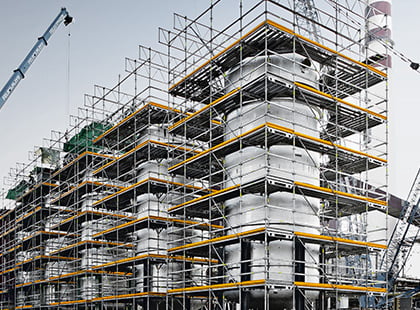Temporary Roof Scaffolding Experts Providing Secure and Reliable Installations
Temporary Roof Scaffolding Experts Providing Secure and Reliable Installations
Blog Article
A Comprehensive Guide to the Necessary Features of Scaffolding in Modern Building And Construction
The landscape of modern building and construction significantly relies on reliable scaffolding systems that focus on efficiency, advancement, and safety and security. As jobs expand in complexity, comprehending the essential attributes of scaffolding ends up being crucial for making sure employee security and maximizing task timelines. This guide explores various kinds of scaffolding, highlights crucial safety and security functions, and analyzes material innovations that add to performance and sustainability. The ramifications of these aspects expand far beyond plain building practices, motivating a better look at exactly how they affect total job success and employee well-being.
Kinds Of Scaffolding
Although scaffolding systems can differ widely in style and application, they typically come under several distinctive groups that deal with various building demands - Scaffolding. One of the most typical types include supported scaffolding, suspended scaffolding, and rolling scaffolding
Sustained scaffolding includes platforms supported by a structure of poles, which give a raised and secure functioning surface. This kind is typically used for tasks that call for significant elevation, such as bricklaying or external painting.
Put on hold scaffolding, on the other hand, is utilized for jobs needing accessibility to high elevations, such as cleaning or fixing structure facades. This system hangs from a roof or an additional framework, permitting workers to lower or increase the platform as needed.
Moving scaffolding functions wheels that enable easy flexibility across a work website. It is particularly helpful for jobs that require regular moving, such as indoor operate in large areas.
Each sort of scaffolding is developed with particular applications in mind, making certain that building projects can be carried out effectively and efficiently. Understanding these categories is vital for selecting the appropriate scaffolding system to meet both project demands and website conditions.
Key Security Features
Safety and security is extremely important in scaffolding systems, as the possible risks connected with operating at elevations can lead to major mishaps if not properly taken care of. Trick safety and security features are important to make certain the well-being of employees and the integrity of the construction website.
Most importantly, guardrails are crucial. These barriers give a physical secure versus falls, considerably reducing the risk of major injuries. In addition, toe boards are frequently utilized to prevent tools and products from dropping off the scaffold, safeguarding employees listed below.
One more important component is using non-slip surfaces on platforms. This attribute boosts hold, particularly in unfavorable weather, consequently minimizing the likelihood of falls and slips. In addition, accessibility ladders should be safely placed to promote secure access and leave from the scaffold.
Routine assessments and maintenance of scaffolding systems are likewise essential. These evaluations guarantee that all components remain in great problem and functioning properly, addressing any kind of wear or damage promptly.
Lastly, appropriate training for all workers included in scaffolding operations is important to make certain that they understand safety and security procedures and can recognize potential dangers. Scaffolding. Jointly, these features produce a much safer working setting and dramatically reduce dangers associated with scaffolding
Product Developments
Developments in product science have dramatically influenced the scaffolding industry, improving both safety and security and performance in modern building and construction. The introduction of high-strength steel and light weight aluminum alloys has reinvented conventional scaffolding systems. These products are not just lighter, making them easier to set up and deliver, yet likewise supply remarkable load-bearing capacities. This results in scaffolding structures that can sustain better weights while lessening the danger of collapse.
Additionally, ingenious composite materials, such as fiberglass-reinforced plastics, have actually become sensible choices. These products are immune to deterioration and ecological destruction, therefore prolonging the lifespan of scaffolding systems, specifically in extreme climate condition. Making use of such materials adds to lower maintenance prices and guarantees constant efficiency over time.


Design Considerations
Taking into consideration the complexities of modern-day building and construction projects, efficient scaffolding style is critical to ensuring both functionality and safety. Layout factors to consider have to include various variables, including tons capability, elevation, and the details requirements of the building site. Each project offers one-of-a-kind challenges, necessitating a flexible approach to scaffolding systems that can adapt to varying problems.
Architectural honesty is important; therefore, engineers must determine the lots that the scaffolding will certainly support, consisting of workers, products, and equipment. The option of materials plays a critical role in making sure the scaffolding can hold up against these loads while remaining long lasting and light-weight. Furthermore, the layout has to permit for simple gain access to and egress, facilitating the smooth movement of personnel and materials.
Safety features, such as guardrails and non-slip surface areas, need to be integrated to reduce threats of crashes. The format must think about the surrounding environment, including surrounding frameworks and potential risks. By addressing these design considerations, building firms can boost the performance of scaffolding systems and advertise a more secure working environment, inevitably adding to the general success of the task.
Maintenance and Inspections
The performance of scaffolding systems expands beyond initial layout and application; recurring upkeep and regular assessments are essential to guaranteeing their continued efficiency and security throughout the period of a project. Normal examinations ought to be carried out by qualified personnel to recognize any type of indications of wear, damages, or instability that can endanger the integrity of the scaffolding.
Maintenance procedures must include regular checks of structural elements, such as frameworks, installations, and slabs, making certain that all elements stay complimentary and safe and secure from deterioration or other deterioration. Additionally, the performance of safety attributes, such as guardrails and toe boards, need to be evaluated to guarantee conformity with security guidelines.
Documents of all evaluations and upkeep tasks is critical for accountability and regulatory conformity. An organized technique to record-keeping not just aids in tracking the problem of the scaffolding but likewise provides required evidence in case of an occurrence.
Ultimately, establishing a comprehensive maintenance and evaluation routine will substantially reduce the threat of crashes and boost the overall security of the construction website. By prioritizing these practices, building and construction supervisors can protect employees and maintain the task's integrity.

Verdict
In conclusion, the crucial attributes of scaffolding in contemporary building incorporate a series of critical aspects, consisting of varied kinds, key security devices, material developments, and thoughtful layout considerations. Highlighting safety and security via guardrails and non-slip surfaces, together with improvements in materials like check here high-strength steel, enhances both efficiency and sustainability. Regular maintenance and examinations are essential for ensuring architectural honesty and security on building sites, inevitably helping with reliable project implementation and advertising the wellness of workers.
The landscape of modern-day building increasingly relies on reliable scaffolding systems that prioritize safety and security, efficiency, go right here and development.Developments in product scientific research have considerably influenced the scaffolding market, boosting both safety and efficiency in contemporary building. Overall, these material innovations not just enhance the efficiency and security of scaffolding systems but also line up with the sector's press in the direction of sustainability, as numerous modern products are made to be much more environmentally pleasant.
Thinking about the intricacies of contemporary building and construction tasks, reliable scaffolding style is critical to ensuring both capability and safety.In final thought, the essential functions of scaffolding in contemporary building and construction incorporate a variety of essential aspects, including diverse kinds, essential security devices, product advancements, and thoughtful style considerations.
Report this page